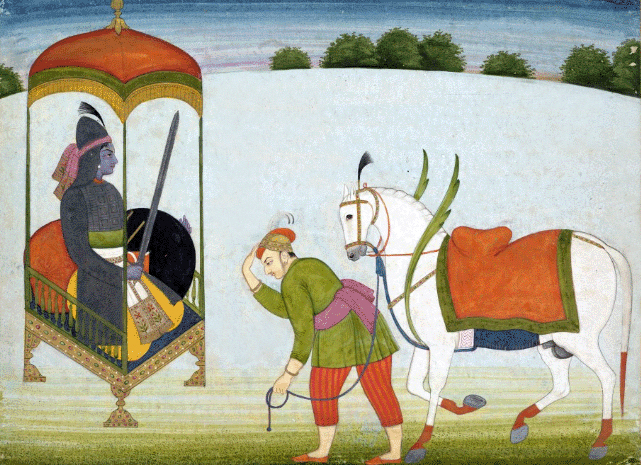
|
|
|
|
BY: SUN STAFF

Kalki Avatar Jan 19, 2012 — CANADA (SUN) — A serial presentation of India's artistic legacy in paintings, sculpture and temple architecture. THE PAHARI SCHOOLS Today we begin a new regional school of miniatures under the category of the Pahari School – the Guler School of painting. Of all the hill states, Guler has perhaps the longest tradition in the art of miniatures. In fact, Guler is often described as the birthplace of Kangra painting. Guler was a small hill state, surrounded by the more prominent hill states of Kangra and Nurpur. Raja Hari Chand (1612-1627 A.D.) constructed a fort at this place and named it Haripur, after himself. Under the later reign of Raja Goverdhan Chand (1744-1773), the Guler School of miniatures flourished there. Goverdhan Chand was a great lover of paintings, and encouraged artists to settle in Haripur, developing their talents under his patronage. Among the many exceptional artists in his court was the famous family of Pandit Seu, and notably his young son Nainsukh. As a miniature artist, Nainsukh's abilities were unparalleled among his peers. As described by Asoka Jeratha in his book, The Splendour of Himalayan Art and Culture, Goverdhan Chand's son, Parkash Chand (1773-1790) was also very fond of miniature paintings, and made the court painters do illustrations of personal pastimes in his private life. He even made them paint scenes featuring his creditors. Parkash's son, Bhup Singh, who became the King of Guler in 1790, did not appreciate his father's extravagant and self-centered lifestyle, and under his rule, most of the artists retired or moved away to other kingdoms due to a withdrawal of patronage. The feudal lord of Kangra, Guler Kalam, thus came to play a decisive role in establishing Kangra Kalam, which became famous in the world of miniatures paintings. In fact, it is sometimes said that the Guler School had its roots in Kangra Kalam.

Krishna Journeying from Gokula to Vrindavan Says historian W.G. Archer, "The state of Guler played a decisive part in the development of Pahari paintings in the 18th century. Not only did it develop the greatest art of delicacy and charm, but the final version of the Guler style was taken to Kangra in about 1780, thus becoming the Kangra style itself." As such, it is not easy to differentiate the Guler Kalam from that of the Kangra Kalam." The Guler School is often described in the context of the Mughal influence that helped to shape it, although as we can see from the paintings shown here, there are equal parts of other indigenous Central Indian schools stirred into the Guler style. In an earlier segment, we pointed out the marked difference in styles found within the Basohli school. Similar points of comparison can be seen in the Guler paintings. For example, the painting of Kalki Avatar is similar in style to the later Basohli School works of the gopis and gopas, rendered in a more casual, naturalistic style: eyes are smaller, drawings have heavier lines, colors lean more to the pastels. The scene of Krishna traveling from Gokul to Vrindavan is a blend of the earlier and later Basohli styles. While overall the scene is more finely drawn than Lord Kalki, the cows and some of the gopas lean towards the later, more casual Basohli style. And in the Wedding of Krishna's Parents, we see a Guler style that is much more in line with the earlier decorative Basohli paintings.

The Wedding of Krishna's Parents For its part, the Mughal style can also be found in Guler works featuring delicate, precise drawings and brightly colored paints, rich in cool blues and greens that glimmer like the surface of water. In the Wedding scene, the Mughal style is seen in the architecture. The Kalki painting, on the other hand, appears to have little Mughal influence, like many of the Pahari Bhagavat illustrations. The Pahari artists also worked for Sikh chiefs during the late 18th Century. As the Sikhs took up rule of a united Punjab and the Hindu kingdoms went into decline, the later generations of these Pahari painters increasingly relied upon the Sikh courts for patronage. Consequently, Sikh paintings are categorized into three distinct classes: Kangra School, Guler School, and Lahore School. In addition to Sikh themes, however, the Guler School artists also mastered both Vaisnava and Rajput style illustrations. Thus, we find many super-excellent miniatures depicting Sri Krsna's Vrindavan-lila pastimes, Visnu incarnations, etc. The Guler School continued to produce miniature works up to the close of the 19th Century. From the earliest extant Guler works up to the pinnacle, with the first generation after Nainsukh and Manaku, many families dedicated to painting in the distinguishable Guler style continued to produce beautiful paintings of liquid grace. Mughal and Sikh styles aside, the Guler Vaisnava paintings are certainly the finest works to have been painted by these artists.
| |